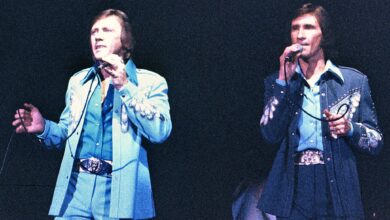The Ventures’ “Walk, Don’t Run” Redefines Instrumental Rock in 1960
In 1960, The Ventures released “Walk, Don’t Run,” a groundbreaking instrumental track that left an indelible mark on rock and roll. During a time when vocal-driven songs dominated the charts, The Ventures proved that instrumental music could be just as emotionally powerful and commercially successful. The song soared to number two on the Billboard Hot 100, firmly establishing the group as pioneers of instrumental rock and surf music.
The Ventures were formed in 1958 in Tacoma, Washington, by guitarists Bob Bogle and Don Wilson. Initially, the duo performed small gigs, driven by their shared passion for rock and roll. Soon, they expanded their lineup with bassist Nokie Edwards and drummer Skip Moore. Unlike other bands of their era that often leaned on charismatic frontmen, The Ventures relied entirely on their musical craftsmanship. Their crisp, clear guitar tones and tight rhythms set them apart, proving that a song could capture listeners without a single lyric.
While “Walk, Don’t Run” is now synonymous with The Ventures, it was originally composed in 1954 by jazz guitarist Johnny Smith. The Ventures, however, drew their inspiration from a more unexpected source — Chet Atkins. His slower, fingerpicked version brought a country flair to the song. Yet, Bogle and Wilson saw its untapped potential. They decided to speed it up, add a driving rhythm, and transform it into a bold rock and roll statement.
The song was recorded at Joe Boles’ modest Seattle studio. The production was simple but effective, emphasizing the clean tones of Bogle’s Fender Jazzmaster guitar. His striking lead riff became the heartbeat of the track, while Wilson’s rhythm guitar and Moore’s steady drumming added undeniable momentum. This raw yet polished approach captured the youthful energy of the era.
Upon its release, “Walk, Don’t Run” was an instant hit. It raced up the Billboard Hot 100, peaking at number two and remaining on the charts for weeks. Music critics praised the song’s fresh sound, and it resonated with fans across the country. At a time when instrumental tracks rarely achieved mainstream recognition, The Ventures proved otherwise. Their success opened the doors for other instrumental bands, expanding the possibilities of rock music.
The cultural impact of “Walk, Don’t Run” was profound. Surf music, which would soon come to dominate the California coast, found one of its earliest anthems in the song. Its infectious energy and upbeat tempo made it a staple at beach parties and youth gatherings. Beyond the surf scene, its influence extended to garage bands and aspiring guitarists, who often learned the song as a rite of passage.
For The Ventures, “Walk, Don’t Run” was just the beginning. The song’s triumph led to national television appearances and a surge in record sales. With their newfound success, they embarked on extensive tours, bringing their electrifying instrumentals to audiences around the world. Recognizing the lasting appeal of the song, The Ventures would even re-record it in 1964 with a slightly updated sound, introducing it to a new generation of fans.
The song’s influence on the music industry was far-reaching. It not only elevated instrumental rock to a new level of prominence but also set a precedent for experimentation in rock and roll. Artists across genres took note of The Ventures’ ability to captivate audiences without vocals. Guitarists like George Harrison and Jimmy Page later credited The Ventures as early inspirations, and the surf rock explosion of the 1960s owed much to the path they paved.
Over the decades, “Walk, Don’t Run” has been covered and reinterpreted countless times. From punk bands to jazz ensembles, each artist brought their own flavor to the iconic track. The song’s adaptability speaks to its timeless quality, proving that a great melody can transcend styles and eras. Despite the countless renditions, The Ventures’ version remains the definitive take, celebrated for its raw simplicity and undeniable charm.
The Ventures’ legacy extended far beyond their initial success. They became cultural icons in Japan, where instrumental rock maintained immense popularity. The band’s ongoing presence and prolific catalog further cemented their status as pioneers of the genre. Even after lineup changes and decades of performing, The Ventures never lost their signature sound.
In 2008, The Ventures were inducted into the Rock and Roll Hall of Fame, a long-overdue recognition of their contributions to music. “Walk, Don’t Run” continues to be celebrated as one of the most influential guitar instrumentals of all time. Its legacy lives on through airplay, film soundtracks, and the countless musicians who attempt to replicate its iconic riff.
Ultimately, the enduring appeal of “Walk, Don’t Run” lies in its pure, unadulterated joy. There are no elaborate lyrics or complex narratives — just the thrilling sound of guitars, drums, and the infectious spirit of rock and roll. For listeners young and old, it remains a reminder of a time when music was about the thrill of discovery and the excitement of a brand-new sound. Decades after its release, The Ventures’ classic still urges listeners to move, groove, and, most importantly, walk — don’t run.



